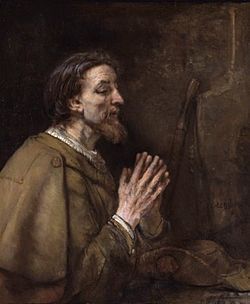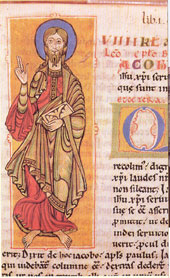James (son of Zebedee) facts for kids
Quick facts for kids Saint James the Greater |
|
|---|---|

|
|
| Apostle and Martyr | |
| Born | 1st century Bethsaida, Galilee |
| Died | 44 AD Judea |
| Venerated in | All Christianity |
| Canonized | Pre-Congregation |
| Major shrine | Cathedral of Santiago de Compostela, Galicia (Spain) |
| Feast | 25 July (Western Christianity) 30 April (Eastern Christianity) 30 December (Hispanic Church) |
| Attributes | Scallop, Pilgrim's hat |
| Patronage | Places Acoma Pueblo, Sahuayo, Santiago de Querétaro, Galicia, Guatemala, Nicaragua, Spain Professions Veterinarians, equestrians, furriers, tanners, pharmacists |
Saint James, son of Zebedee (died 44 AD) was one of Jesus's twelve main followers, known as the Apostles. He was the son of Zebedee and Salome, and the older brother of John the Evangelist. To tell him apart from another apostle also named James, he is often called Saint James the Greater.
Contents
Who Was Saint James the Greater?
James was one of the first people to join Jesus. The Bible tells us that James and his brother John were with their father by the sea. Jesus called them to follow him, and they left everything to travel with him.
The "Sons of Thunder"
According to the Gospel of Mark, Jesus called James and John "Boanerges." This means "Sons of Thunder." This nickname might have been because of their strong personalities.
His Early Death
The Bible's book of Acts of the Apostles says that King Herod had James killed with a sword. This happened around 44 AD. James was likely the first of Jesus's apostles to die for his faith. This makes him an important martyr in Christian history.
Saint James and Spain
There is an old story that Saint James traveled to Spain. He supposedly preached the Christian message there. This happened around the year 40 AD.
The Virgin Mary's Appearance
The story says that the Virgin Mary appeared to James in Spain. This happened by the Ebro River in a city called Caesaraugusta (now Zaragoza). She appeared on a pillar, which is now kept in a church in Zaragoza. After this, Saint James returned to Judea.

The Journey of His Relics
After James was killed in Jerusalem, a legend says his body was taken by angels. It sailed in a boat without a rudder all the way to Spain. The boat landed at Iria Flavia in Galicia. His body was then moved to Compostela. A large rock supposedly closed around his remains.
The Discovery of His Remains
The story of Saint James's remains being found in Compostela became very important. This happened during the time of King Alfonso II (791–842). Bishop Theodemir of Iria also played a part in this discovery.
The Famous Pilgrimage to Santiago
The discovery of Saint James's remains led to a famous pilgrimage route. This route started in the 9th century. The church built for James in Santiago de Compostela became a very important Christian site.
The Way of Saint James
The pilgrimage route is known as the St James's Way. It is a network of paths that cross Western Europe. All these paths lead to Santiago de Compostela in northern Spain. Over time, James became the patron saint of Spain.
The Scallop Shell Symbol
The name "James" comes from "Iacobus" in Latin. In Spain, it became "Iago" or "Santiago." Saint James's special symbol is the scallop shell. Pilgrims traveling to his shrine often wear this shell on their hats or clothes. It is a way to show they are on the journey.

